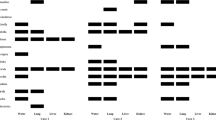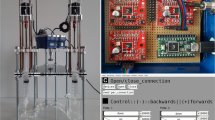Abstract
Diatom test has been widely used in the diagnosis of drowning and inferring the drowning site. One of the issues is whether the concordance of the diatom types and patterns between the drowning victim’s organs and media should be considered an essential requirement for the diagnosis of drowning. In this study, lung tissues from 20 rabbits and drowning media were studied by the Microwave Digestion–Vacuum Filtration–Automated Scanning Electron Microscopy method, and four methods, type consistency, coefficient of similarity, squared-chord distance, and cluster analysis, were introduced to analyze the diatom types and patterns for evaluating the value of diatom consistency in drowning cases. The results showed that diatom types and patterns in lung tissues do not perfectly match the drowning medium, and they are sometimes concordant with the drowning medium sampled from other than drowning site. We should be cautious when using diatom detection to infer drowning sites.




Similar content being viewed by others
References
Piette MH, De Letter EA (2006) Drowning: still a difficult autopsy diagnosis. Forensic Sci Int 163(1–2):1–9
Zhou Y, Huang P et al (2020) Research advances in forensic diatom testing. Forensic Sci Res 5(2):98–105
Auer A (1991) Qualitative diatom analysis as a tool to diagnose drowning. Am J Forensic Med Pathol 12(3):213–218
Hürlimann J, Feer P, Elber F, Niederberger K, Dirnhofer R, Wyler D (2000) Diatom detection in the diagnosis of death by drowning. Int J Legal Med 114:6–14
Zhao J, Liu C, Bardeesi A, Wu Y, Ma Y, Hu S, Cheng J (2017) The diagnostic value of quantitative assessment of diatom test for drowning: an analysis of 128 water-related death cases using microwave digestion – vacuum filtration – automated scanning electron microscopy. J Forensic Sci 62:1638–1642
Lunetta P, Penttilä A, Hällfors G (1998) Scanning and transmission electron microscopical evidence of the capacity of diatoms to penetrate the alveolo-capillary barrier in drowning. Int J Legal Med 111(5):229–237
Zhang P, Zhao J, Liu C et al (2020) The length and width of diatoms in drowning cases as the evidence of diatoms penetrating the alveoli-capillary barrier. Int J Legal Med 134(3):1037–1042
Cong B (2016) Forensic pathology. People’s Medical Publishing House, Beijing
Krstic S, Noveska M et al (2002) Diatoms in forensic expertise of drowning-a Macedonian experience. Forensic Sci Int 127(3):198–203
Li H, Zhao J et al (2020) Are diatom types or patterns in the organs and drowning medium of drowning cases always consistent? Aust J of Forensic Sci 1:1–10
Zhao J, Liu C, Hu S, et al (2013) Microwave Digestion–Vacuum LS. Filtration-Automated Scanning Electron Microscopy as a sensitive method for forensic diatom test. Int J Legal Med 127 (2):459–463
Zhang Y (1998) Coefficient of similarity - an important parameter in floristic geography. Dili Yan- jiu 17(4):429–443
Gavin DG, Williams JW et al (2003) A statistical approach to evaluating distance metrics and analog assignments for pollen records. Quaternary Res 60(3):356–367
Sc C, Horton BP, Boreham S et al (2006) The development and application of a diatom〣ased quantitative reconstruction technique in forensic science. J of Forensic Sci 51(3):643–650
Ludes B, Coste M, North N, Doray S, Tracqui A, Kintz P (1999) Diatom analysis in victim’s tissues as an indicator of the site of drowning. Int J Legal Med 112(3):163–166
Coelho S, Ramos P, Ribeiro C, Marques J, Santos A (2016) Contribution to the determination of the place of death by drowning - a study of diatoms’ biodiversity in Douro river estuary. J Forensic Leg Med 41:58–64
Lai X, He Q, Lin H et al (2012) A study on community distribution of diatoms in tributaries of Dongjiang River within Dongguan administrative area where drowning occurs frequently and its applicability in forensic practice. Zhongguo Fayixue Zazhi 27(1):25–28
Acknowledgements
The authors gratefully thank Dr Sherry Ma for assistance in preparing the manuscript. This study was financially supported by Guangzhou Municipal Science and Technology Project (2019030001; 2019030012) and Grant-in Aids for Scientific Research from Ministry of Public Security of the People’s Republic of China (2020GABJC38).
Funding
Science and technology commission of shanghai municipality,2019030001,Jian Zhao,guangzhou science,technology and innovation commission,2019030012,Chao Liu,ministry of public security of the people's republic of china,2020GABJC38,Chao Liu
Author information
Authors and Affiliations
Corresponding authors
Ethics declarations
Ethical approval.
The Laboratory Animal Ethics Committee of Southern Medical University (L2020064).
Informed consent
Not applicable.
Conflict of interest
The authors declare no competing interests.
Additional information
Publisher's note
Springer Nature remains neutral with regard to jurisdictional claims in published maps and institutional affiliations.
Rights and permissions
About this article
Cite this article
Du, Y., Liu, J., Li, Q. et al. Concordance analysis of diatom types and patterns in lung tissue and drowning medium in laboratory animal model. Int J Legal Med 136, 911–917 (2022). https://doi.org/10.1007/s00414-021-02768-9
Received:
Accepted:
Published:
Issue Date:
DOI: https://doi.org/10.1007/s00414-021-02768-9




